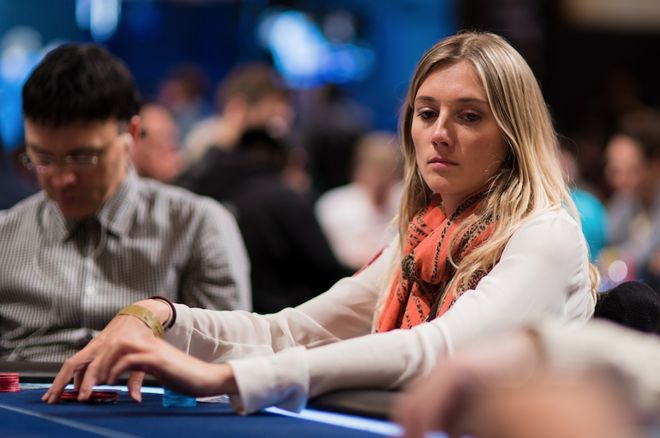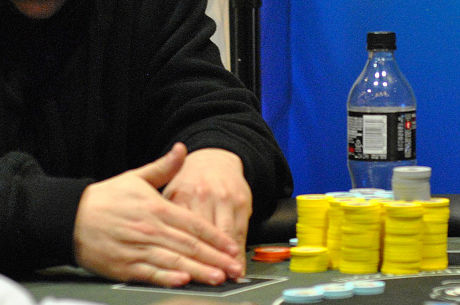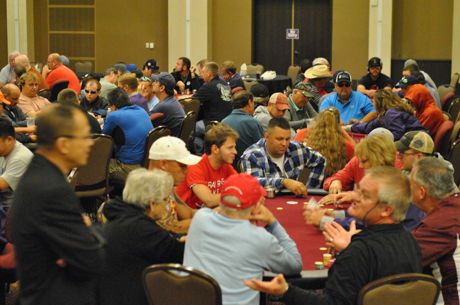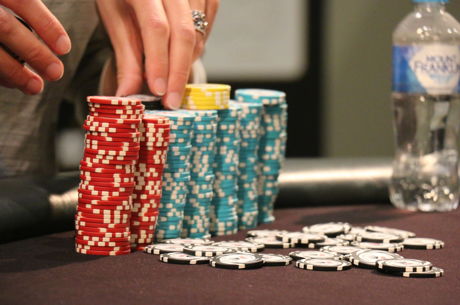Maximizing Value and Controlling the Pot Size Simultaneously

Maximizing value and controlling the size of the pot sound like two competing concepts. While watching ESPN's coverage of the 2016 World Series of Poker Main Event, I saw a player put both skills into practice simultaneously. The hand was included in Episode 3 and is between Gaelle Baumann and Drew Dumanski.
Preflop: Four-Bet or Call with Ace-King?
The hand comes from Day 5 when there were about 230 players left. With the blinds at 12,000/24,000 with a 4,000 ante, Baumann began with 1.75 million while Dumanski had 1.9 million.
Baumann starts the hand by opening to 55,000 from three off the button with A?K?. Action folds around to Dumanski on the button and he decides to three-bet to 140,000. We want to view this hand from Baumann's perspective, so I will not reveal Dumanski's cards until the end.
It folds back around to Baumann who has to decide if she wants to four-bet or just call.
Baumann started the hand with 73 big blinds, so four-bet shoving would be a massive overbet and isn't a line she is likely to take. A smaller four-bet would be reasonable, but we have to consider how that would affect Dumanski's continuing range.
If he just calls a four-bet, she will have to play a big pot out of position against a player with a bigger stack. This is not a fun spot in which to be, especially in the WSOP Main Event. If he were to respond with a five-bet, he's likely only doing so with a range that is in good shape against A?K?. Not many players are willing to five-bet bluff from these stack sizes this deep in the Main Event.
So whether he calls or reraises, Baumann will be playing in a difficult situation. I believe this is why she elected to just call. This line allows her to control the pot size when she is behind as well as to maximize value when she is ahead by forcing Dumanski to play postflop with his bluffs.
The Flop: Raise or Call with Top Pair, Top Kicker?
The flop comes 7?J?K? giving Baumann top pair, top kicker. She checks and Dumanski bets 155,000 into a pot of 352,000.
Baumann is faced with a decision very similar to the one she faced preflop. She holds a strong hand and has to decide if she wants to raise or just call.
Again, she is in a situation where she is either way ahead of his bluffs and most one-pair hands or way behind his pocket aces or two-pair or better hands. Like before, a call here allows her simultaneously to maximize value against the bluffs and control the pot size when she's behind.
The Turn: Call or Raise with Top Two Pair?
The turn brings the A? giving Baumann top two pair. She checks and Dumanski bets 280,000 into a pot of 662,000.
Although her hand has improved, she is once again in the same situation. She is still behind 7x7x, JxJx, KxKx, and AxAx, and now she is behind Qx10x as well. That said, she is more likely to have the winning hand now given that KxKx and AxAx are blocked by the cards in her hand as well as the ones on the board.
Many players would choose to raise here because the turn brought a flush draw, but notice almost all of the premium flush draws are blocked by the A? and J? on the board as well as the K? in her hand. Dumanski doesn't have many flush draws to protect against and she can't expect to get called by worse if she raises, so again she just calls to control the size of the pot, now up to 1.22 million.
The River: Bet or Check with a Full House?
The river brings the miracle K?. Now Baumann is only losing to the one combo of pocket aces. If he has that, I imagine she would always go broke with only a pot-sized bet behind.
By this point controlling the pot size is no longer a concern. She now has to decide the best way to maximize value.
Leading out on this river would be a super weird line, but I'd like it against players who love to call and would have a hard time folding. From what we can gather from Dumanski's actions in this hand, he prefers betting to calling, so I don't mind Baumann's decision to check to him once again, possibly to get one more bet from his bluffs. Unfortunately for her, he doesn't fall for it and gives up with his 10?7?.
Conclusion
In this hand, Gaelle Baumann faced a similar dilemma on every street. She had a strong hand, but her opponent was representing an even stronger hand. Coming over the top of his bets at any point would likely have caused him to fold many of his bluffs, therefore strengthening his continuing range to the point that maybe her strong hand would no longer be strong enough.
In cases like this one, just calling is the best way to control the size of the pot when you are behind and maximize value against bluffs when you are ahead.









